Mahout - Save The Elephants
Secure a future for endangered African elephants by a smart collar powered by Edge Impulse, Avnet IOT Connect and Helium Network.
👹 On Going Crisis
Accurate estimates suggest that there were 12 million elephants in the early 1900s. Today there are only 350, 000, which includes both savanna elephants and forest elephants.

That’s a 97% decline in just one century. At current mortality rate this species will extinct by 2030 !
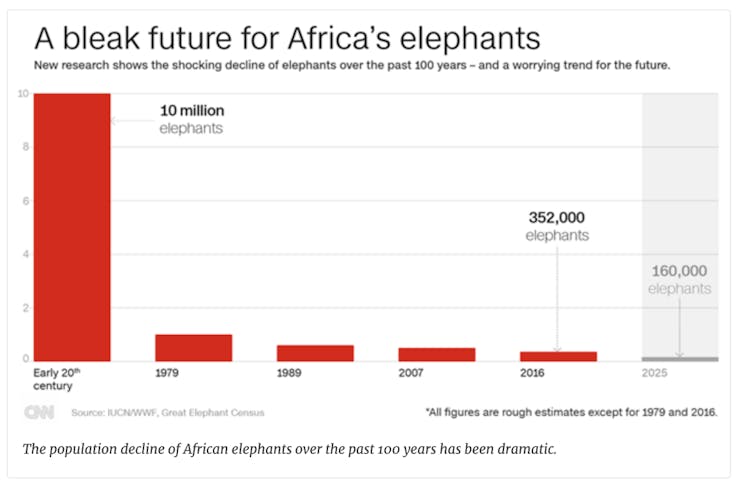
Botswana is the largest home for African elephants (130, 000) followed by Zimbabwe.
Poachers are the biggest threat to African elephants. As per source, Poachers are currently shooting elephants at a rate of about 100 per day, or about 30, 000 every year. In other words, about 10% of the population is being wiped out ever year. More elephants are being killed than being born.
According to National Geographic, a pair of ivory chopsticks can sell for several thousand dollars, and carved tusks can sell for hundreds of thousands of dollars. This money is the reason poachers
While poachers are the biggest threat to African elephants, there are number of other factors which are playing big roles in reducing the numbers very fast such as environment, human-elephant conflicts and sudden aggressive behavior of young male elephants due to hormonal surges a.k.a Musth.
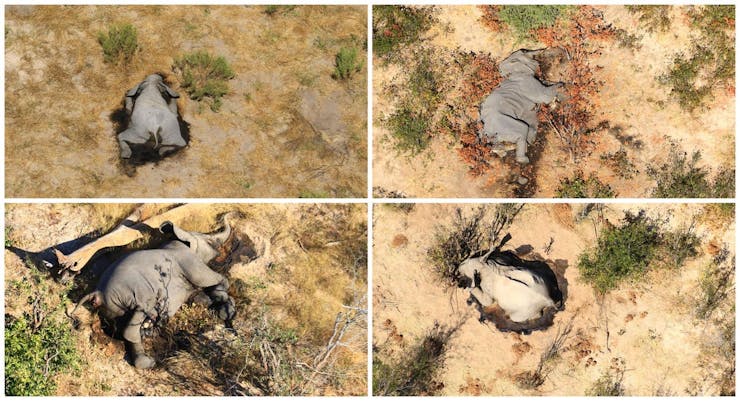
More than 350 elephants died in just few months in Botswana in early 2020. While the cause of death is still unknown but based on the information we have so far could be due to environmental issues such as soil poison, lack of water.
"Musth" (Musth or must /ˈmʌst/; from Persian, 'drunk') is a periodic condition in male elephantscharacterized by highly aggressive behavior and accompanied by a large rise in reproductive hormones. A musth elephant, wild or domesticated, is extremely dangerous to both humans and other elephants. There are several reported incidents of musth elephants killing other elephants, buffalos and even villagers. Study has indicated, putting elder male elephant in the pack help reduce the the aggressiveness in young musth elephants.
Elephant-human conflict poses a great threat to their continued existence. Studies on conflict between elephants and humans in Asia and in Africa have identified crop raiding as the main form of conflict. Elephant-human conflict is a result of habitat loss and fragmentation. When elephants and humans interact, there is conflict from crop raiding, injuries and deaths to humans caused by elephants, and elephants being killed by humans for reasons other than ivory and habitat degradation.
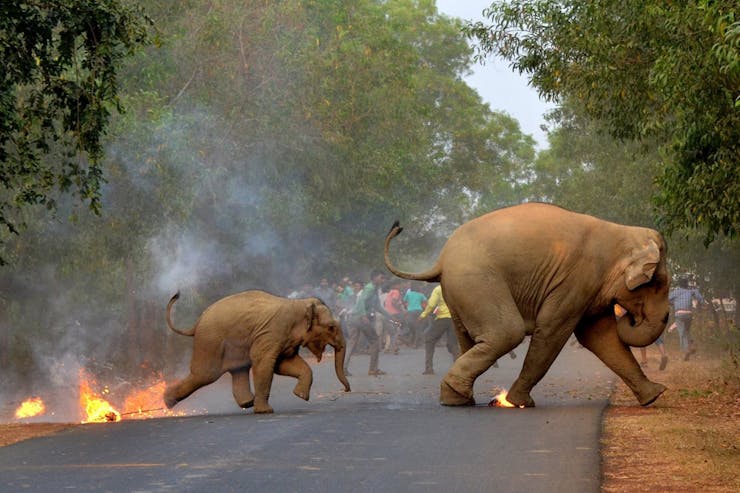
Elephants cause damage amounting from a few thousand dollars to millions of dollars. Every year, 100 humans (in some years it may be 300 people) and 40-50 elephants are killed during crop raiding in India. Source.
So, based on all the research I have done so far following are the major threats elephant population in Africa as well as in Asia.
- Illegal killing of elephants or poaching
- Human-elephant conflict
- Musth or aggressive behavior of male elephant
- Environmental issues such as wild fire, drought etc
Most, if not all of the above situations can be handled or avoided if park rangers or authorities are notified timely.
🧠 Mahout - The Elephant Collar with A Brain
Introducing Mahout a smart elephant collar with GPS tracker and artificial intelligence on the edge (TinyML)

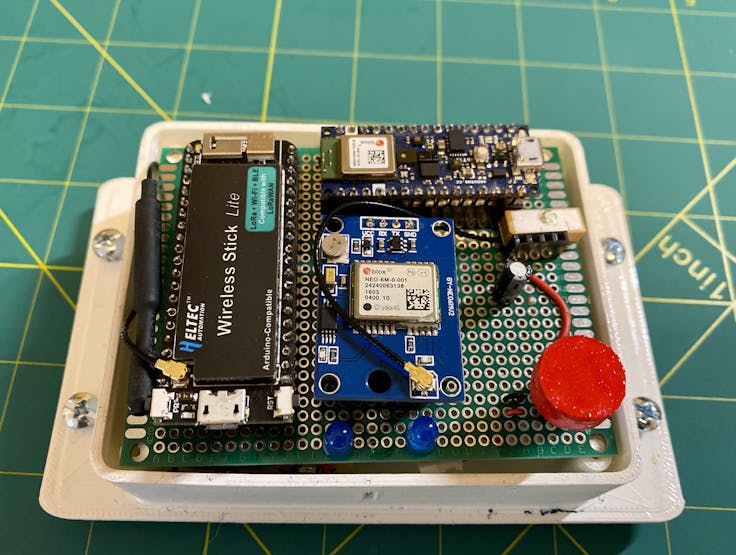

The collar uses two MCUs along with a Ublox GPS tracker and MQ135 air quality sensor. Two MCUs used in the collar are -
Heltec Wireless Stick Lite ( based on ESP32 chip )
This MCU has BLE 4 and LoRa module. BLE 4 module is used to scan any mobile or bluetooth device near elephant which indicates human presence. LoRa module provides capability to connect to LoRaWan based Helium network without any need of WiFi or GSM.
Arduino Nano BLE Sense
This MCU is mainly used to run edge impulse model locally. It has on-board microcontroller, 3 axis accelerometer and temperature & humidity sensor. 3 axis accelerometer data is feed to edge impulse model to predict elephant's activity such as resting, walking, running or musth behavior.
The microphone is used to capture voice around the elephant and feed to another model to predict situations such as trumpet or rumbling, poachers etc.
Temperature, humidity and air quality are used in combination to predict if there is any fire in the wild.
Nano sends data to Heltec over UART and Heltec sends data to Helium network in certain interval.
The collar is powered by 18650 batteries. I have not done much research on long battery life as that's already done by smart park & open collar.
🎃 Demo
🖥️ Architecture
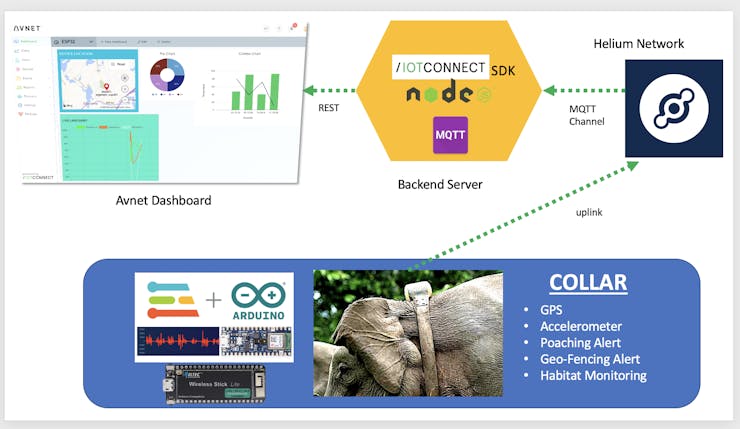
Entire ecosystem is comprised of 4 components
- The Collar - which we explained above.
- Helium Network - which is backed by LoRaWAN, first people's network ever. Helium publish messages to MQTT channel when it receives UPLINK data from the collar.
- NodeJS Backend - which uses IoT Connect SDK to interact with Avnet IoT Connect dashboard. It listens for incoming messages from MQTT.
- Avnet IoT Connect Dashboard - Visualization of the sensor data and alerts to help park rangers monitor important data most effectively and get notified of any situation such as elephant moving out of park, entering into risk zone or any sign of human presence.
For further information on this project, checkout Hackster.io
